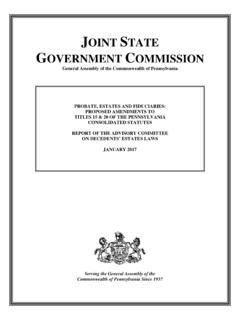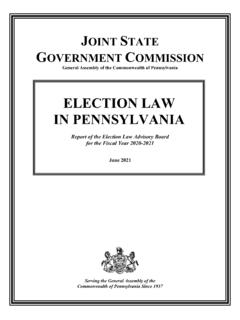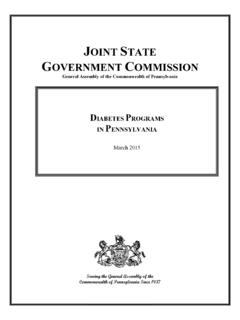Transcription of LAWS REGULATING SCHOOL NURSES IN PENNSYLVANIA …
1 LAWS REGULATING . SCHOOL NURSES IN PENNSYLVANIA . AND OTHER STATES. JULY 2004. General Assembly of the Commonwealth of PENNSYLVANIA JOINT STATE GOVERNMENT COMMISSION. 108 Finance Building Harrisburg, PENNSYLVANIA 17120. 1. The release of this report should not be interpreted as an endorsement by the members of the Executive Committee of the Joint State Government Commission of all the findings, recommendations or conclusions contained in this report. Joint State Government Commission Room 108 Finance Building Harrisburg, PA 17120-0018. Telephone 717-787-4397. Fax 717-787-7020. E-mail: Website: _____. The Joint State Government Commission was created by the act of July 1, 1937 ( , ) as amended, as a continuing agency for the development of facts and recommendations on all phases of government for the use of the General Assembly.
2 _____. 2. TABLE OF CONTENTS. INTRODUCTION .. 9. STUDENTS' health CONDITIONS .. 11. SCHOOL health 13. FUNCTIONS OF SCHOOL NURSES IN 17. STATE SUPPORT FOR SCHOOL NURSE 25. SCHOOL NURSE CERTIFICATION REQUIREMENTS .. 29. 29. OTHER STATES' SCHOOL NURSE 35. Statutory SCHOOL Nurse Provisions .. 35. Regulatory 46. CONTINUING PROFESSONAL DEVELOPMENT .. 51. SCHOOL NURSE-TO-STUDENT 53. Other 53. 57. APPENDICES .. 59. Appendix 1: House Resolution No. 427 of 2003, Printer's No. 2713 .. 61. Appendix 2: Requirements for SCHOOL Nurse Certification in PENNSYLVANIA .. 63. 3. 4. JOINT STATE GOVERNMENT. COMMISSION 2004. OFFICERS. Senator Roger A.
3 Madigan, Chair Representative Jeffrey W. Coy, Treasurer _____. EXECUTIVE COMMITTEE. Senate Members House Members Robert C. Jubelirer John M. Perzel President Pro Tempore Speaker David J. Brightbill Samuel H. Smith Majority Leader Majority Leader Robert J. Mellow H. William DeWeese Minority Leader Minority Leader Jeffrey E. Piccola Brett O. Feese Majority Whip Majority Whip Michael A. O'Pake Michael R. Veon Minority Whip Minority Whip Noah W. Wenger Elinor Z. Taylor Chair, Majority Caucus Chair, Majority Caucus Jack Wagner Mark B. Cohen Chair, Minority Caucus Chair, Minority Caucus MEMBER EX-OFFICIO. Roger A. Madigan, Commission Chair _____.
4 David L. Hostetter, Executive Director _____. 5. 6. 7. 8. INTRODUCTION. An important figure in the lives of PENNSYLVANIA 's two million SCHOOL -aged children is the SCHOOL nurse. Most people associate the SCHOOL nurse with her traditional function of providing medical aid to students and staff. However, the SCHOOL nurse plays a significant role beyond patching skinned knees. The health of the students in an entire building or SCHOOL district can be significantly affected by the actions of the SCHOOL nurse. The nurse's role is comprehensive enough such that the children can be screened for a number of conditions, such as asthma and diabetes, and act as a powerful preventative measure.
5 SCHOOL NURSES also deal with issues such as drug and alcohol abuse, SCHOOL violence and teenage pregnancy. Their services are provided within the framework of professional nursing practice, through which the NURSES address the physical, mental, emotional and social health of their students. The duties and functions of SCHOOL NURSES are determined, in large part, by the health conditions of the populations they serve. As licensed health care providers, the SCHOOL NURSES must respond without direct medical supervision to the unique health related issues present in their schools. Some schools populations, especially in urban settings, may struggle with widespread asthma.
6 Rural districts may face a dearth of nursing services outside of the SCHOOL setting. SCHOOL NURSES , in providing these SCHOOL -based services, fulfill the mandates of both federal and state statutes and regulations. But more precisely, they use the mandates as the baseline of services and often play larger roles than those prescribed by law. Many NURSES readily act as counselors and confidants to their students to help them cope with health issues that might not require professional medical care. Their experience in dealing with young people strengthens the education the NURSES themselves received in earning their degrees.
7 As certified educational specialists, the SCHOOL NURSES ' role is to support student success in the learning process. Certainly, a child who is not in good health cannot perform well in the classroom. House Resolution 427 of 2003 directs the Joint State Government Commission to conduct a study on how other states' laws provide for certified SCHOOL nursing services within the SCHOOL environment, including a look at ratios between NURSES and students, and the education and certification requirements for SCHOOL NURSES . This report if the culmination of that study. 9. As background, the report lists health conditions that are reported in PENNSYLVANIA 's schools.
8 The report then lists the health services provided by certified SCHOOL NURSES and describes the SCHOOL NURSES ' functions as health care providers and certified educational specialists. The report next shows health services provided by SCHOOL NURSES in other states along with the SCHOOL NURSES ' responsibilities in delivering those services. A summary of statutory provisions is provided and a section details selected states' SCHOOL nurse responsibilities. Certification, licensure, and continuing education requirements for PENNSYLVANIA and other states' SCHOOL NURSES are discussed as well. Finally, the report addresses the issue of SCHOOL nurse-to- student ratios, including the relevant provisions in PENNSYLVANIA and other states, and data on the numerical ratios for schools in the United States.
9 10. SCHOOL health CONDITIONS. Contagious diseases such as tuberculosis, diphtheria, measles, mumps, rubella, and whooping cough were at one time the most formidable challenges facing SCHOOL NURSES , but are not as prevalent as they once Instead, SCHOOL NURSES battle many social problems that plague current-day SCHOOL children, such as homelessness, drug and alcohol abuse, poverty, pregnancy, and violence. According to the department of Education and the department of health and Human Services, more than 100,000 children are homeless on any given It has been reported that up to 22 percent of ninth graders carried a weapon to SCHOOL during a one month time Two-thirds of eighth graders have tried alcohol, and 28 percent have been drunk at least For the 2001- 02 SCHOOL year, the PENNSYLVANIA department of health (DOH) reported that 6,671 women under the age of 17 were pregnant and over 275,000 PENNSYLVANIA children between the ages of 5 and 17 were living in The SCHOOL NURSES '.
10 Firsthand knowledge of the medical and social conditions that exist in their schools is valuable to policy makers at SCHOOL district and state levels. Each SCHOOL nurse is responsible for collecting and reporting student heath data to district authorities, who then forward them to the DOH Division of SCHOOL health . The DOH maintains a database of SCHOOL health statistics, which is used in part for purposes of reimbursing SCHOOL districts under the Public SCHOOL Code of 1949 (PSC). The reported conditions, such as asthma, neurologic disorders, and diabetes are examples of the types of medical situations SCHOOL NURSES treat on a daily basis.





